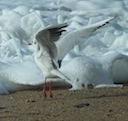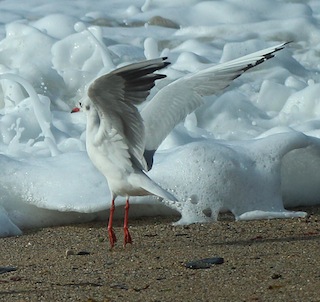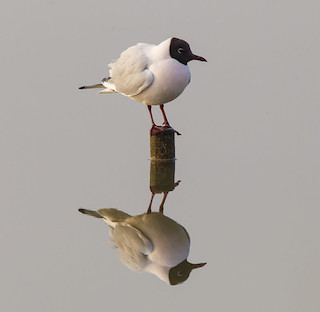 Black-headed Gulls form large flocks in the autumn and winter months.
Black-headed Gulls form large flocks in the autumn and winter months.
Photo: Amanda Scott
Scientific name: Chroicocephalus ridibundus
Cornish name: Golan is the general word for a gull
Conservation status: UK Birds of Conservation Concern, Amber (due to declines in non-breeding population); IUCN Red List, Least Concern.
What to look for:
- Family: Laridae (gulls)
- Colouring and appearance: The dark brown plumage of the head develops during the breeding season – for the rest of the year the head is white with a dark smudge behind each eye. This small gull has a reddish bill and legs, pale grey body and black-tipped primaries. The white leading edge to its slender wings is distinctive in flight. First-year juveniles have darker wings, a yellowish bill and a less-developed hood in the summer.
- Size: Length 35 to 39 cm, wingspan 86 to 99 cm.
- Where: Mostly inland in groups or larger flocks. They can also be spotted by the coast outside the breeding season, but do not venture out to sea.
- Call: A ‘kree-ar’ sound
- Similar species: The Mediterranean Gull, which is slightly larger and, in the breeding season, its head is all black, compared to the dark ‘facemask’ of the Black-headed Gull.
 The Black-headed Gull is our most common inland gull. Globally, its breeding range extends across Europe and Asia, with a population also to be found on the eastern coast of Canada. Here in the UK it is both a migrant and resident breeder (140,000 pairs), with these numbers swollen to over two million individuals in the winter as migrants from continental Europe join our resident birds. Flocks are a common sight in urban areas, but this is a relatively recent adaptation, dating from the ‘Little Ice Age’ of the late nineteenth century when they were attracted to towns and cities by the availability of food.
The Black-headed Gull is our most common inland gull. Globally, its breeding range extends across Europe and Asia, with a population also to be found on the eastern coast of Canada. Here in the UK it is both a migrant and resident breeder (140,000 pairs), with these numbers swollen to over two million individuals in the winter as migrants from continental Europe join our resident birds. Flocks are a common sight in urban areas, but this is a relatively recent adaptation, dating from the ‘Little Ice Age’ of the late nineteenth century when they were attracted to towns and cities by the availability of food.
 Look closely at the dark hood Black-headed Gulls wear in their breeding season, and you’ll see it is actually a dark chocolate brown, not the black their name suggests. This ground-nesting inland gull breeds in noisy colonies, using marshy areas, reedbeds or lake islands. Each clutch of eggs contains two or three brown speckled eggs, and the parents share incubation duties. With a bit of luck and successful predator avoidance, the fledglings might expect a long life – Black-headed Gulls have been known to live for over thirty years.
Look closely at the dark hood Black-headed Gulls wear in their breeding season, and you’ll see it is actually a dark chocolate brown, not the black their name suggests. This ground-nesting inland gull breeds in noisy colonies, using marshy areas, reedbeds or lake islands. Each clutch of eggs contains two or three brown speckled eggs, and the parents share incubation duties. With a bit of luck and successful predator avoidance, the fledglings might expect a long life – Black-headed Gulls have been known to live for over thirty years.
In the autumn and winter Black-headed Gulls form gregarious flocks, feeding together on their broad diet of invertebrates, worms, scraps, carrion, fish and seeds. Although an inland gull, in the colder months you can also spot them on the beach, where pickings are good amongst the seaweed washed ashore. They also roost together on open fresh water or, less frequently, estuaries.
Did you know…?
…In the book Watership Down by Richard Adams, Kehaar is a short-tempered but good-hearted Black-headed Gull who befriends the rabbits and helps them on their journey.
…The species name ridibundus means ‘laughing gull’, a reference to the cackling sound of their call.
More information and references:
Svensson, L., Mullarney, K., Zetterstrom, D.,1986. Collins Bird Guide, second edition (translated by Christie, D., Svensson, L.). HarperCollins, London.
Published: October 2014
Author: Amanda Scott
Photos: Black-headed Gull reflected in water, © Natural England/Allan Drewitt; other photos, Amanda Scott

